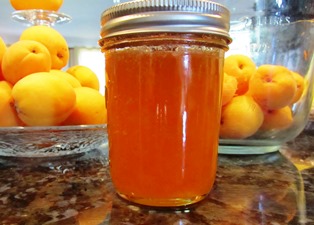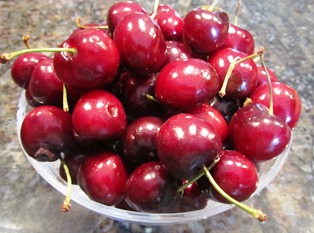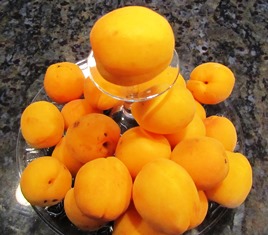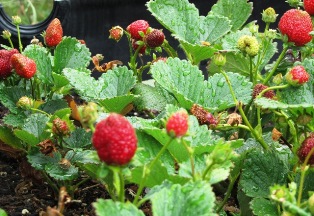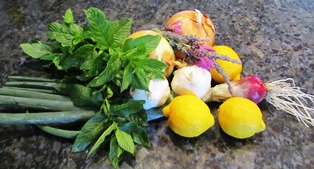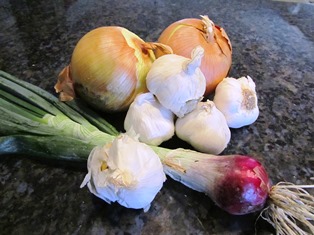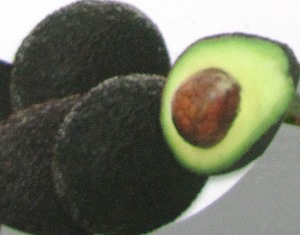Archive for May, 2013
Jam, Jelly, Conserve, & Fruit Butter
I admit to having a weakness for palate-pleasing soft spreads made from fresh fruit. My taste for fruit spreads started in my childhood with my grandmother, who introduced me to the process of picking and preserving the fresh seasonal fruits we found on the farm–mulberries, damson plum, blackberries, gooseberries, and peaches.
My grandmother would load the breakfast table with hearty farm-to-table foods and hot, freshly made biscuits that we slathered with butter. I could always count on at least a couple of bowls of jams or jellies. For us farmers, breakfast and lunch were the most important meals of the day, providing us with energy for the hours of toil that followed those meals.
Later, as an avid traveler, I fondly remember breakfasts in the United Kingdom and throughout Europe, especially France, where my petit déjeuner included strong coffee, juice, and bread (usually some type of roll such as brioche or croissant), butter, and an exquisite soft spread of jam, jelly, fruit butter, or conserve. You might wonder, what’s the difference?
Jam: made from fruit, sugar, and pectin (to thicken) that are boiled to achieve a spreadable consistency
Jelly: made from juice (from various ingredients or fruit that has been crushed and strained), sugar, pectin, and acid, gently boiled to render clear color and firm shape
Conserve: fruit and nut spreads that are chunky; they make a nice condiment for certain meat dishes and cheeses, like a goat cheese with fig-walnut conserve
Preserves: fruit in jelly
Fruit Butter: made from fruit that has been slow cooked until creamy and color is opaque or translucent
As I write this, I have four cases of organic ripe apricots and cherries on my kitchen counter from the farmer’s market. So, like my grandmother, I’m going to eat my breakfast and then work for the next several hours preserving these delicious seasonal fruits into spreads for future breakfasts.
Letting a Plant Go to Seed
Some lettuces, basil, and Greek oregano have spontaneously appeared in my garden. No surprise in that since I let some of my herbs and vegetables go to seed last year.
We used the rototiller on the garden area twice before planting this year. By the time we turned the soil, the vegetables and herbs I had planted last year were a memory. That said, some certainly did re-seed and the evidence of that are the new plants popping up where I didn’t plant them this year.
Open-pollinated vegetable and herb seeds, well tended (meaning, meeting the seed needs of light, water, and good soil), will go through the cycle of sprouting, pushing up through the earth, blooming, bearing, and dying. If you let your plant go to seed and the wind broadcasts the seed or it drops, you will likely (in the case of oregano, basil, chives, and other herbs and some vegetables) get new offspring.
The plant that the mother seed produced will also yield seed (and if you are smart and save some), that seed will repeat the same cycle and the vegetable will also be a true likeness of the original seed. Everything starts with the integrity of the seed.
This is why open-pollinated (OP) seed continue to perform in the same way their ancestors have for hundreds, even thousands of years. And nature’s plant cycles make that possible.
Jam to Die For
My husband brought home three cases of apricots from the farmer’s market over the weekend so I have to make jam whether I’m ready or not. Since I wanted to finish the murder mystery I am writing, I pushed the jam making off my to-do list for a couple of days because making jam, like writing a book, requires my full attention.
But I figured out a way to do both. Yesterday I wrote a whopping 20 pages (some in the morning, the rest at night) and made eight jars of jam (in the afternoon).
Today, I hope to write an equal number of pages (since the end of the book is within striking distance) but I also want to make two dozen jars of apricot jam. Both types of work are labor intensive.
Thank goodness that crafting a mystery doesn’t mess my office like jam making messes the kitchen–in fact, the room begins to resemble the aftermath of a cyclone. The cleanup can take hours. But the jam is so worth the effort. I can only hope that my mystery turns out as good as my jam.
Stinking Away Gophers
In anticipation of the city-wide garage sale this weekend, I’ve been walking around the property, looking for things to sell and making a to-do list. That is, until my foot disappeared into a freshly dug tunnel. Now all I can think about is how to get rid of the gophers.
A newly erupted, fan-shaped mound of dirt with a hole off to the side suggested a gopher had been tunneling underground in my yard. How do I know it’s a gopher and not a mole? The fan-shape ridge of soil and complete disappearance of plants are telltale signs of the presence of a gopher.
Moles tunnel but don’t consume plants. They feed on grubs and worms. Their soil ridges are shallow and near the surface.
Frankly, I don’t mind the moles as much as the gophers. Moles are harmless and their tunnels, although ugly, aerate the soil. But gophers are destructive. In the last two weeks, I have witnessed how a gopher can take down a lush garden. A number of organic plants, tomatoes, cilantro (young leafy coriander), and hot peppers that were planted last month have been decimated in less than a week by gophers.
I have searched magazines, newspapers, and the Internet for ways to get rid the pesky critters. I don’t want to use poison or cages. I am more interested in using all-natural caster oil granules. But I haven’t seen a lot of testimonials about the effectiveness of the granules in repelling gophers. The caster oil does not kill gophers. When the granules are watered, they release a scent that is supposed to repel gophers and moles. In fact, you can direct the vermin from your property by strategic application of the granules–1 pound to 1,000 square feet. A spreader makes it easy to spread the granules evenly.
So, I’ve added buying and spreading caster oil granules to my list. I’m going to stink them away.
Post script: Several days have passed with no new gopher mounds on the farmette, so I believe the caster oil method worked.
Fairy-Folks Fingers Look Great in Borders and Beds

Foxglove flowers look like bells or the fingers of a glove making an attractive spire on a leafy stalk
In the folklore of Wales, the Foxglove plant is commonly known as “fairy-folks fingers” and also “lambs tongue leaves.” Americans recognize it the digitalis plant, an old-favorite for flower gardens.
Foxglove’s botanical name is Digitalis purpurea but gardeners in Great Britain (especially Scotland and Wales) where Foxglove grows as a wildflower know it by more colorful names: Bloody Fingers, Witches Bells, Dead Man’s Fingers, Fairy Caps, Fairy Glove, Virgin’s Glove, Folk’s Glove, and Fairy Thimbles.
My garden and planter boxes include several Foxglove plants ranging in color from white to a dusty shade of rose. The flowers are tubular and measure between 1 1/2 to 2 1/2 inches. Because the plants can grow 2 to 5 feet tall, they are especially good choices for color at the back of a flower bed.
Foxglove plants are considered poisonous. But the plants readily re-seed themselves, are excellent cut flowers for a summer bouquet, and are deer resistant. Plant in full sun or light shade and keep the soil moist, albeit well-drained.
Best time to plant Foxgloves is in the spring or fall. When cutting blooms from the plant, remember that cutting the central upright stalk will cause the plant to produce lateral shoots for new blooms. If the plant is not cut, the flowerheads produce seed that self-sows. If you want an elegant back border for your flower garden, consider planting Foxgloves. Plants are available in many colors are low maintence.
Mother’s Day Means Preparing for Stone Fruit Season
Mother’s Day marks for me the beginning of stone fruit season. The peaches, apricots, plums, and cherries will begin to ripen within a week or two. In my grandmother and mother’s kitchens in rural Missouri, the preparations for making jam began as soon as the fruit’s color changed.
I begin my search for jars, lids, rings, spoons, funnels, labels, and other canning supplies as soon as I notice that fruit color shift. I like to have everything washed, cleaned, sterilized, and organized before the fruit is ready.
This is the time, too, to organize the kitchen and storage areas. All those jars of jam will have to be stored somewhere. Right now the cottage doesn’t have much room–a little space is available beneath the cabinets off the kitchen in the bar area.
I’m thinking metal shelving could go into another area, a separate room that currently houses the water heater and furnace (turned off most of the year) since the climate is so mild.
Finally, I’ll be searching new versions of recipes for jam that go beyond the basics. I’ve added rum, spices, and vanilla bean to previous peach jams. This year, I’m interested in trying a recipe that involves the addition of smoky chipotle chilies to the jam. I’d also like to try to make a chunky blueberry-peach jam.
For my jams, I use organic fruit grown here on the farmette or purchased at my local farmers market from certified organic farms and suppliers. Using organic fruit means you can feel confident that the jam that you eat, feed your family, and give to friends is wholesome and safe to consume. What Mother’s Day breakfast tray would be complete without a luscious fruit jam?
Natural Medicines For Healing and Health
Recently, I went through a box of books that I had not unpacked after moving from Miami to Northern California. In the box was Best Remedies, a book written by Dr. Mary L. Hardy, M.D. and Debra L. Gordon for Reader’s Digest.
The book focuses on ways to use natural remedies alone or with conventional medicines in an integrative approach to healing. Many of the remedies involve the use of herbs, honey, vegetables, and oils. Listed below are just a few remedies to treat common maladies.
Chamomile
Chamomile is an herb that when made into tea can be used as a mild sedative and also fights the inflammation of a sore throat. Likewise lemon and honey in hot water can soothe swollen throat tissue.
Echinacea
For treating colds, a tincture of Echinacea purpurea and Echinacea angustifolia can provide relief when made into a tincture and mixed with hot water. Authors Hardy and Gordon recommend 1/4 – 1/2 teaspoon of the tincture in 1-2 ounces of hot water to be consumed every four to six hours.
Garlic
Traditionally used as an herbal remedy for respiratory infections, garlic, to be most effective, must be consumed raw. The best way is to peel and mash 3-4 cloves into pasta, rice, or mashed potatoes.
Ginger Root
For treating bad breath, tea made from ginger root (1- to 2-inch pieces, peeled and steeped in hot water, sweetened with honey) or peppermint tea (all types of mint are easily grown in the garden or in containers) can be effective agents.
Lavender Oil and Aloe Vera
Oil of lavender works as an inflammation and pain reducer while acting as an antiseptic; therefore, it’s a wonderful natural agent for treating minor burns. Once you have applied the lavender oil, you can also apply the sap of an aloe vera plant. Aloe reduces the pain of a burn and promotes healing.
Lemon Juice and Honey
Honey, one of nature’s antiseptics long used to treat respiratory ailments, provides a protective coating of the throat and acts as a humectant (drawing moisture) while the lemon works as an astringent to reduce swelling of inflamed throat tissue.
Olive Oil, Beeswax, and Honey
These three ingredients mixed together in equal parts can be used to treat psoriasis, a disease characterized by itchy, scaly skin. The authors recommend smoothing the mixture onto the affected area of skin before going to bed at night and then covering the skin with plastic wrap, held in place with an elastic bandage.
Onions and Garlic
Onions and garlic are recommended as two vegetables that can lower blood sugar, cholesterol, and blood pressure. Onions are high in vitamin C and, and like garlic, contain immune-enhancing compounds. Garlic reduces blood clotting (thus, preventing heart attacks) and raw garlic has strong immune-stimulating properties as well as antibacterial and antiviral benefits. For people with chronic diseases such as Type 2 Diabetes, these foods should be a regular part of the diet, according to Hardy and Gordon.
St. John’s Wort
St. John’s wort essential oil–10 drops to 1 ounce massage oil–massaged into the skin over painful areas over time may result in relief from nerve pain. Patients who have fibromyalgia, diabetic neuropathy, shingles, Lyme disease, autoimmune disorders, and other types of diseases can suffer nerve pain as stabbing, burning, and shooting sensations. Other herbs believed to revitalize nerve and brain cells include Gotu kola (an herb considered a mainstay in Ayurvedic medicine) and Evening primrose oil that fights inflammation and is found in black currant and borage oil.
Grow these herbs in a garden or in containers on your patio for use to restore and maintain health and also for enhancing flavors in your cooking.
Seven Tips for Growing Sweet Corn
Nothing says “summer” like juicy ears of sweet corn. Corn (or maize, as it is called in much of the world) isn’t difficult to grow but following a few tips can ensure success in growing this amazing plant.
What would a summer backyard barbecue be without a platter piled high with corn on the cob? And what could be better than picking it fresh?
We planted corn last year and still had a few ears that the squirrels hadn’t found. When I discovered them a few weeks ago, I removed the dried husk and planted some of the seed. Amazingly, the seeds grew and are now over a foot tall.
If you want to grow corn, it is helpful to understand several points.
1. Corn seeds won’t germinate in soil colder than 50 degrees. So wait until the soil is warm to plant your seeds.
2. Wind is the pollinator for corn, so do not plant your seed corn in straight rows. Instead, plant the seeds in blocks. Corn is monoecious, meaning the male and female parts are on the same plant. Block planting enables better pollination.
3. Plant corn kernels (two or three seeds) 15 inches apart in rows 30 to 36 inches apart.
4. After planting the corn seeds, water well. Corn needs plenty of water and nutrient-rich soil high in nitrogen. Dig in some aged manure to help meet the corn’s nitrogen needs.
5. Fertilize plants when they have reach 12 to 15 inches in height.
6. Weed often, but take care not to damage the corn roots. Compost can help keep weeds at a minimum and also adds nitrogen to the soil.
7. To harvest corn, bend the ear downward and twist from the plant. Remove husk and silks before cooking or freezing.
A little known fact about sweet corn comes by way of horticultural specialist Jonathan R. Schultheis, University of North Carolina Extension, who notes that the first known variety of sweet corn, Papoon, was acquired from the Iroquois Indians in 1779. See, http://www.ces.ncsu.edu/hil/hil-13.html
Whether you call it sweet corn or maize or classify it as vegetable or grain–these terms won’t matter as much as the word, “delicious” when it comes time to serving your home-grown corn to family and friends.
Cinco de Mayo Fresh Guacamole
What better way to enjoy Cinco de Mayo (Mexico’s victory over the French in 1862) than with a yummy guacamole, made with fresh ingredients from your garden or farmers market, piled onto your favorite organic chips?
Here’s my recipe for guacamole using onions I planted in February (that nowhave large bulbs), garlic from last year’s crop, and the freshest organic tomato and avocados I could find.
Ingredients:
1 medium red onion
1-2 cloves of garlic
1 ripe tomato
2 large ripe avocados
1-2 Tablespoons fresh cilantro leaves
1/2 teaspoon Kosher or coarse salt
1/4 teaspoon ground cumin
1/8 teaspoon cumin seeds
1 teaspoons garlic powder
juice of one lemon
freshly ground, cracked black pepper to taste
*add serano chilies, seeded, washed, and chopped for heat, if you like
Directions:
Finely chop the onion and garlic and set aside.
Wash and coarsely chop the tomato.
Peel and remove each seed from the avocados and cut the flesh into cubes.
Wash the cilantro leaves and tender stems and finely chop.
In a medium-size bowl, combine the onion, garlic, tomato, avocado, cilantro, and spices.
Add the lemon juice and gently mix and mash, but don’t overdo as it the consistency should be a little chunky.
Add pepper.
Taste and correct seasoning, if necessary.
If you are using hot chili peppers, add small portions at a time to the guacamole, checking the heat by tasting.
This guacamole tastes wonderful on homemade taco chips or organic blue corn tortilla chips.
New Kind of Seed Farm Addresses Shrinking Biodiversity
I save things; seed, for example. But I also save magazines and recently I found a National Geographic from last year with an article I’d flagged to re-read. The piece focused on heirloom seeds and the real concern for diminishing biodiversity and food shortages on our planet.
Author Charles Siebert noted in his National Geographic article that “it took more than 10,000 years of domestication for humans to create the vast biodiversity in our food supply that we’re now watching ebb away.” See, http://ngm.nationalgeographic.com/2011/07/food-ark/siebert-text
Humans are creatures of habit who become complacent. Our reliance upon commercially produced fruits and vegetables means thousands of open-pollinated, heirloom varieties have already disappeared.
What started out with the best of intentions (improve the world food supply), the so-called “green revolution” has been fraught with negative consequences. There was the strong allure of higher yields through the planting of monocrops in vast fields (to the exclusion of crops with lower-yields but that were better adapted to local conditions). The genetically-weaker monocrops required, according to Siebert, “expensive chemical fertilizers and toxic pesticides.”
Seeds hold our future, states “Tom Stearns, Founder of High Mowing Organic Seeds, a company focused on the cultivation, improvement, protection, and preservation of organic seeds and making them available to farmers, gardeners, commercial growers, and others.
I recently sent for High Mowing’s catalog of organic seeds. Not only did the catalog contain a multitude of seed listings (650 varieties), but throughout the pages were stories of how the independently owned company works with partners to educate people about the importance of protecting the genetic integrity of seed so our food supply remains strong, safe, and diversified. See, http:www.highmowing seeds.com
I think it’s kind of cool to grow the vegetables that my grandmother grew in her garden and perhaps her grandmother also grew. It might be time for all of us who love to garden to start saving seed as if the diversity and abundance of the food supply for our generation and those of the future depended upon it.
 Facebook
Facebook Goodreads
Goodreads LinkedIn
LinkedIn Meera Lester
Meera Lester Twitter
Twitter




